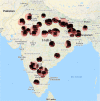FiSH: fair spatial hot spots
- PMID: 36415752
- PMCID: PMC9672600
- DOI: 10.1007/s10618-022-00887-4
FiSH: fair spatial hot spots
Abstract
Pervasiveness of tracking devices and enhanced availability of spatially located data has deepened interest in using them for various policy interventions, through computational data analysis tasks such as spatial hot spot detection. In this paper, we consider, for the first time to our best knowledge, fairness in detecting spatial hot spots. We motivate the need for ensuring fairness through statistical parity over the collective population covered across chosen hot spots. We then characterize the task of identifying a diverse set of solutions in the noteworthiness-fairness trade-off spectrum, to empower the user to choose a trade-off justified by the policy domain. Being a novel task formulation, we also develop a suite of evaluation metrics for fair hot spots, motivated by the need to evaluate pertinent aspects of the task. We illustrate the computational infeasibility of identifying fair hot spots using naive and/or direct approaches and devise a method, codenamed FiSH, for efficiently identifying high-quality, fair and diverse sets of spatial hot spots. FiSH traverses the tree-structured search space using heuristics that guide it towards identifying noteworthy and fair sets of spatial hot spots. Through an extensive empirical analysis over a real-world dataset from the domain of human development, we illustrate that FiSH generates high-quality solutions at fast response times. Towards assessing the relevance of FiSH in real-world context, we also provide a detailed discussion of how it could fit within the current practice of hot spots policing, as read within the historical context of the evolution of the practice.
Keywords: Fairness in AI; Hot spot detection; Unsupervised learning.
© The Author(s) 2022.
Conflict of interest statement
Conflicts of interestThe authors confirm that they do not have any conflicts of interest to declare.
Figures










References
-
- Abraham S.S, P D, Sundaram S.S (2020) Fairness in clustering with multiple sensitive attributes. In: EDBT, pp 287–298
-
- Bera S.K, Chakrabarty D, Flores N, Negahbani M (2019) Fair algorithms for clustering. In: NeurIPS, pp. 4955–4966
-
- Bhattacharya A, Varambally S, Bedathur A.B.S (2021) Frocc: fast random projection-based one-class classification. SIGKDD
-
- Binns R (2020) On the apparent conflict between individual and group fairness. In: FAT*
-
- Borzsony S, Kossmann D, Stocker K (2001) The skyline operator. In: ICDE
LinkOut - more resources
Full Text Sources
